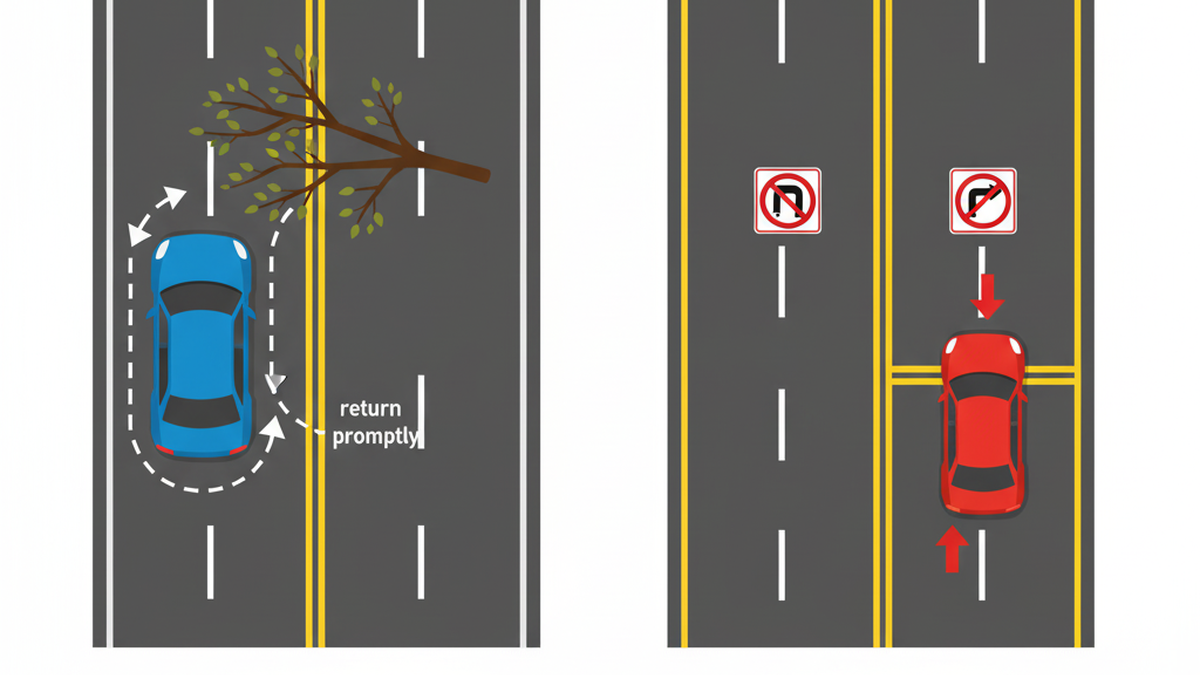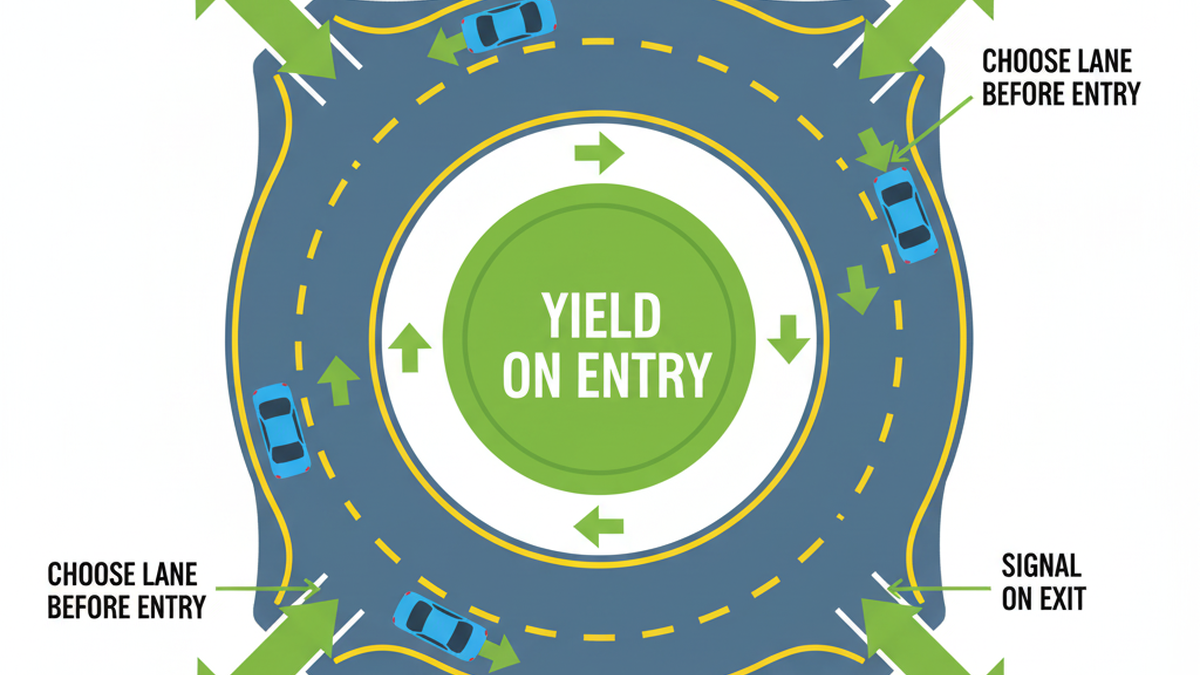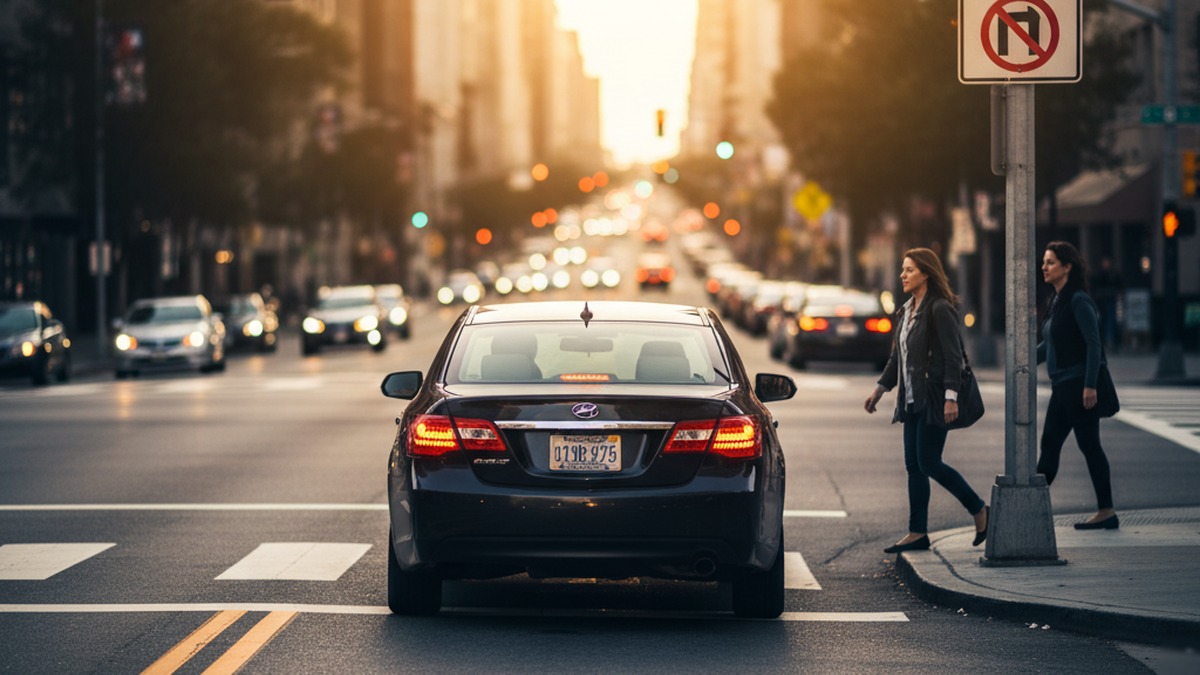Right-of-way rules at intersections and roundabouts
Right-of-way is the backbone of safe intersections. It decides who may proceed and who must yield, and it is referenced in crash reports and citations. States phrase the core idea similarly: yield to people already in the intersection or crosswalk and to traffic that entered first. When in doubt, slow and let others go—it is both lawful and safer.
Four-way stop order and who goes first
At a four-way stop, the vehicle that arrives first goes first after a complete stop. If two arrive together, the driver on the right has priority. Left turns yield to straight/right traffic. Rolling through the sign ("California roll") risks a stop-sign citation and liability in a collision.
Ties, courtesy waves, and rolling stops to avoid
Courtesy waves can be misunderstood; instead, make eye contact and proceed only when others visibly yield. Keep your bumper behind the limit line until it is your turn.
Pedestrian right-of-way in marked and unmarked crosswalks
Crosswalks exist at most intersections even without paint. People in the crosswalk—and those approaching from the curb—have priority. If a pedestrian hesitates, hold your position and invite them through by waiting; do not wave them into traffic.
Camera and officer enforcement at stop signs
Some cities cite rolling stops where tires never stop moving. Officers also watch for blocking crosswalks and failing to yield to people already stepping off the curb.
Roundabout driving rules and yield on entry
Roundabouts reduce severe crashes when drivers yield on entry and select the correct lane before entering. Traffic inside has priority. Signal right as you exit; do not stop in the circle except to avoid a collision. For complete details, see our roundabout right-of-way guide.
Signaling on exit and lane selection in multi-lane circles
Choose the outer lane for right/straight and the inner lane for left/U-turn unless signs show otherwise. Signal right as you pass the prior exit.
Trucks, buses, and large-vehicle aprons
Large vehicles may track onto the truck apron; do not overtake them in the circle.
Common roundabout tickets and how they're written
Typical citations include failure to yield on entry, wrong-lane exit, and failure to signal on exit—especially at multilane designs with high volumes.
Uncontrolled intersections and first-arrival priority
Where no signs exist, slow and yield to vehicles already in the intersection and to those on your right if you reach it together. Treat blind corners as yield-controlled.
Sight-distance and speed control approaching residential corners
Parked cars, hedges, and grade changes shorten visibility. Cover the brake and approach at a speed that allows stopping within your sight line.
Bikes and micromobility in the conflict area
Cyclists have full lane rights where lanes are narrow. Expect scooters and e-bikes near schools and campuses; yield when crossing bike lanes to turn right.
Winter/low-visibility right-of-way cautions
In rain, snow, or glare, expand your gap and look for reflective crosswalk bars or pedestrian signals to confirm the intersection status.
Speed limits, school zones, and work zones
States use a mix of absolute and prima facie limits. Exceeding an absolute limit is automatically unlawful; exceeding a prima facie limit can be rebutted by proving your speed was safe for conditions, though that is rarely simple. When signs flash or workers are present, slow immediately.
Prima facie vs. absolute speed limits explained
Urban streets often use absolute limits; some residential and rural roads still reference prima facie language. Either way, basic speed law always applies: never drive faster than is safe for conditions, even below the limit.
Variable speed signs and flashing beacons in school zones
Follow the lowest applicable value: posted time ranges, flashing beacons, or "when children are present." If more than one applies, obey the strictest. Learn more about school bus stop laws and how they interact with school zones.
When school zone times apply (dates, days, flashing rules)
Many districts post school days only. Some use year-round calendars or summer programs. Beacons normally control; if they are flashing, slow regardless of the time plaque.
Insurance surcharges for school-zone violations
Insurers often weight school-zone tickets heavily. Even a small overage may carry surcharges for multiple policy terms.
Work-zone rules and temporary traffic control
Cones, temporary signs, and portable signals create a short-term road environment. Respect barriers and do not drive in closed lanes even if traffic is light.
Flagger instructions override normal signs and signals
A certified flagger's "stop/slow" sign legally overrules the traffic signal. Watch for pilot cars and single-lane alternating traffic.
Double fines and worker-present provisions
Many states enhance penalties when workers are present. Drive as if barriers may hide equipment or people just beyond your sight.
Photo enforcement and speed-safety cameras
Work-zone cameras are expanding. Signs typically announce camera use; keep your lane and speed steady through the entire zone.
Move-over law and emergency scenes
When you approach vehicles with flashing lights on the shoulder, move one lane away if safe. If you cannot, slow significantly—many statutes cite a specific speed reduction or a "safe and reasonable" requirement.
Lane change vs. slow-down thresholds
Even when traffic blocks a lane change, you are still required to reduce speed. Activate your turn signal early to show intent and create space.
Tow trucks, utility vehicles, and hazard-light exceptions
Many states include tow, sanitation, and utility vehicles in move-over coverage. Give them the same margin you would a police cruiser.
Reporting crashes and the "steer it, clear it" guidance
If a crash is minor and drivable, most states ask you to move out of live lanes. Exchange information in a shoulder or parking lot.

Signals, lane changes, following distance, and turns
Signals communicate intent and create gaps. Combine early signaling with smooth speed changes and eye contact where appropriate. Keep at least a 3-second following distance in dry conditions; add seconds for speed, rain, or darkness.
Turn-signal timing and lane-change distance
Many DMVs teach signaling for at least 100–200 feet in urban areas and longer on highways. Maintain your signal through the maneuver and cancel after completion.
Blind-spot checks and bike-lane conflicts
Check mirrors, then glance over the shoulder into the blind area. When a bike lane runs to the corner, merge into it cautiously to turn right, yielding to cyclists first.
Merging zipper method on on-ramps
Use the acceleration lane to match speed, signal early, and zipper merge at the lane end. Avoid stopping on the ramp unless traffic requires it.
Left-lane passing and keep-right-except-to-pass
The left lane is primarily for passing on multi-lane roads. After overtaking, return to a right lane to keep traffic flowing and avoid left-lane impeding tickets.
Full stop, right turn on red, and posted restrictions
You must stop completely before a right on red and yield to cross traffic and people in the crosswalk. "NO TURN ON RED" signs—including time-based plaques—override general permission. Our right turn on red rules guide covers all the exceptions and state-by-state variations.
"NO TURN ON RED" and time-based plaques
If the plaque shows hours (e.g., 7–9 AM, 4–6 PM), treat it as a ban during those windows only. Some cities apply blanket bans in downtown cores—watch for signs at each approach.
Pedestrian priority and leading pedestrian intervals (LPI)
LPIs give people a 3–7 second head start before vehicles get green. Even with a green signal for you, pedestrians already in the crosswalk still have priority.
Red-light cameras and rolling-right turn citations
Many right-on-red tickets come from failure to stop before the turn. Count a calm pause behind the line—even when the lane looks empty.
U-turns, double-yellow lines, and median barriers
Across a single double yellow, many states allow a safe U-turn unless signs prohibit it. But two sets of double yellow—the "double-double" painted median—function as a barrier: do not cross or make a U-turn except at designated openings. See our detailed guide on U-turns across double yellow lines for state-specific rules.
Legal U-turns across a single double yellow
Ensure long sight distance and no posted restriction. Yield to faster traffic and complete the turn without backing.
"Double-double" painted median—no crossing except openings
Treat double-double segments like a raised median. Look for breaks signed for left turns or U-turns. Crossing mid-segment is commonly cited.
Obstruction avoidance: cross only as far as necessary
When an obstacle blocks your lane, many states allow a brief centerline encroachment only as far as needed and when clear—then return promptly. Read more about when you may cross a double solid yellow line.

For deeper, statute-based explainers, see our comprehensive guide on Rules of the Road, detailed coverage of Right Turn on Red, Left on Red (one-way), Roundabout Right-of-Way, U-Turn Across Double Yellow, and when you may cross a double solid yellow line.
